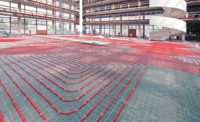Jeremy Waits continues to reach for the sky.
Waits, a senior associate and plumbing engineer at Atlanta-based Jordan & Skala Engineers, has taken eight of his SkyHouse apartment complex designs to construction with the latest opening in Austin, Texas.
The SkyHouse Austin is a 23-story, 320-unit building in the growing capital region in Texas. Waits believes Austin has made a point of emphasis to try its best to retain the graduates of the University of Texas to live and work in the area and the need for living space is critical.
SkyHouse high-rise buildings, which are owned by Atlanta-based Novare Group, also are located in Houston; Dallas; Atlanta (three units); Raleigh, N.C.; Charlotte, N.C.; Orlando, Fla.; and Tampa, Fla. Waits says more SkyHouse buildings are coming in the near future, some of which are near the construction phase.
“This is the growing trend and it is aimed at young professionals,” Waits says. “We are doing these buildings throughout the Southeast. They want in-town living that is close to the nightlife and trendy restaurants, especially in Austin, where there is a nice music scene, too.”
Up to the challenge
Waits says the Novare Group wished to maintain high ceilings wherever possible, including as much exposed slab that could be provided. Originally, the SkyHouse Austin was designed around CPVC piping, but PEX was utilized to meet the owner’s requests.
“We were given less than 12 inches of ceiling space above bathrooms and portions of the kitchens to route all plumbing, HVAC and electrical,” he states. “Using PEX allowed the contractor the flexibility to route the lines and to minimize conflicts with the other trades.”
With extensive experience in residential high-rise building design, Waits says the toughest task to meet is ensuring that the critical inner workings of the plumbing design work in concert with the overall aesthetic of the property.
“It is always difficult to properly route the sanitary stacks and water risers throughout the tower while maintaining ceiling heights at offsets and coordination with the architectural elements of the project,” he says.
Waits adds: “When you start to offset the stacks — where a unit does not stack with a larger unit (above or below) — with the ceiling restraints, typically they will give us another 12 inches to work with.”
At SkyHouse Austin, Waits did receive the additional space to work with, but it still could be a difficult task to manage.
“Even with that, it presents challenges to coordinate with mechanical, electrical and all the other elements within the unit to make sure we get systems installed within the ceiling area provided to us,” he says.
To maximize the flexibility of his system design, Waits specified Uponor multiport tees with PEX.
“This allowed the contractor to run main lines to the bathroom and kitchen groups, and then branch off to each fixture,” Waits says. “Doing that decreased the amount of joints in the system.”
Waits, who has been with Jordan & Skala Engineers for 15 years, says Uponor PEX is the first choice on the company’s PEX designs. At SkyHouse, he specified Uponor PEX ranging from 1/2 in. to 2 in. with ProPEX engineered polymer fittings.
“It is the standard we use as a company,” Waits says. “We like Uponor because of the way everything is put together. The type of fittings that are used, the method of joining the pipe to the fittings is great and we just like the way everything is installed.”
Unique to the area
The SkyHouse Austin building also is unique to the region because Waits’ design was granted a rare exception from the city. The sanitary lines for the high-rise are a cast-iron Sovent system, which Waits reports the city of Austin has only approved for a few buildings.
“Typically, conventional systems are required,” Waits says. “As an engineered system, the design team presented to the city our proposal for using cast-iron Sovent as part of an alternate method of compliance.
“We were granted this compliance and were allowed to design and install the first Sovent system in the city of Austin in years.”
Waits and the SkyHouse owners were pleased to receive approval because of the savings they would see in both cost and labor time by installing the cast-iron drainage, waste and venting system. With the approval, the need to provide venting was dramatically reduced.
“A Sovent system is designed where you do not have to vent every fixture,” Waits says. “Each fixture is vented by the system itself. The system’s fittings at each floor provide that venting. When you are working on a high-rise or multifamily building, a Sovent system is the way to go.”
In general, the 320 units at SkyHouse Austin are stacked and uniform, according to Waits. But, they do vary in size, ranging from one to three bedrooms and baths.
“They do have offsets to the plumbing,” he says.
Waits designed a domestic booster pump system for SkyHouse Austin to elevate any concerns for pressure drops in the high-rise.
“Each residential unit was provided with a pressure-regulating valve to control the incoming pressure to no more than 50 to 55 psi,” he says.
Getting a feel
When the time came to start construction on SkyHouse Austin, the Houston-based mechanical contracting firm Kilgore Mechanical had to be comfortable with using Uponor’s PEX materials. Enter Pepco Sales & Marketing — pme’s sister publication Plumbing & Mechanical’s 2015 Manufacturers Rep of the Year.
Brittany Moreland, Pepco Sales’ outside salesperson who covers the Austin market, took Kilgore and two of its contractors on a tour of projects in the middle of PEX installations.
“It was helpful for them to see other projects in process,” Moreland says. “It spurred a healthy conversation among peers on the benefits of using PEX over other products.”
SkyHouse Austin was designed for and achieved Energy Star certification, Waits notes. The engineer specified Kohler low-flow plumbing fixtures, including 1.28-gpf water closets to meet the Energy Star requirements.
“When we first started doing these SkyHouse projects, the owner and the design team got together to decide which products we wanted to use,” Waits says. “Kohler products are what we chose.”
Amenities galore
SkyHouse Austin features a pool on the roof of the building with an adjacent club room and fitness center. The main floor of the building is the spot for the leasing office and retail shops, including an in-building coffee shop.
Waits says the push for new apartment complexes in the city has increased the installation of pools on the roof and other left-of-center designs.
“The buildings are so compact now,” he adds. “They do not have the space on the lower levels to put pools and other amenities there. Up until we started doing these high-rises, we were not used to seeing pools and amenities spaces such as that found in these spaces on the roof. But that does seem to be the norm now.”
The pool in SkyHouse Austin provided enough space for Waits to work with.
“It did not present too much of a challenge,” he says. “They have the pool equipment room on the very top of the roof feeding down. We had enough space below to be able to accommodate everything.”
Waits continues to be impressed with the growing SkyHouse market and how the facility can add to a city’s overall backdrop.
“The SkyHouse program started with the first building in Atlanta,” he says. “SkyHouse Austin was the first one outside of the Atlanta area and the second one in a line of many being constructed all over the Southeast. Being part of the design team and bringing the SkyHouse program to Austin was full of challenges, but rewarding in seeing the finished product and what it adds to the city’s residential landscape.”
This article was originally titled “A view from the top” in the July 2015 print edition of PME.







